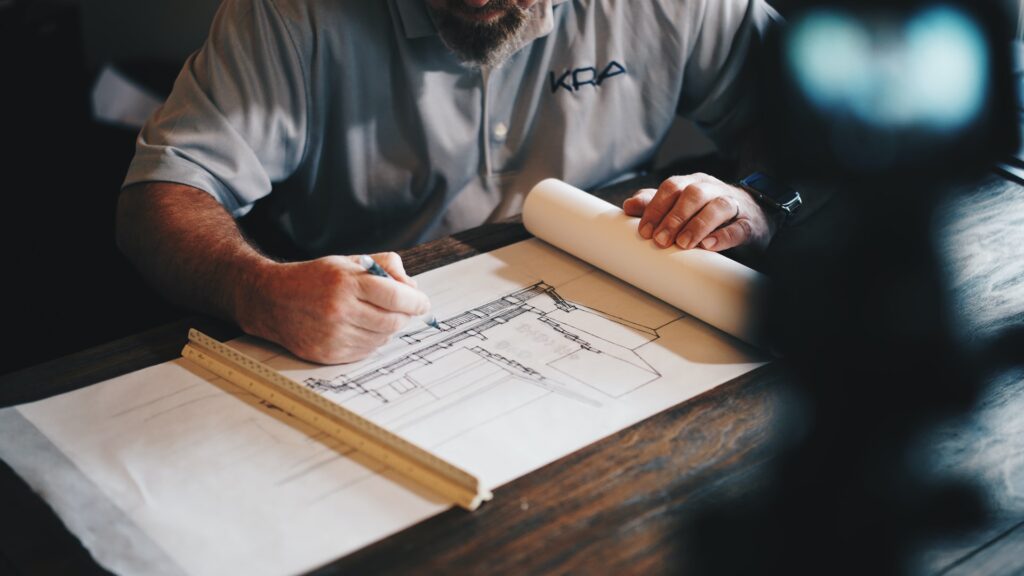
If you’re designing a home from the ground up, you will be able to choose the exact layout or floor plan that your new home will have. A home’s layout involves the positioning of the rooms, walls, windows, and doors in a home. The layout of your home can play a significant role in what it looks like and how comfortable the interiors are to live in. Choosing the layout or floor plan for your new construction home is among the most important decisions that you’ll be tasked with making during the home-building process.
There are three types of floor plans available to you, which allow you to select the layout that best suits you and your family. The types of floor plans to select from including traditional floor plans, contemporary floor plans, and custom floor plans. When you’re in the midst of designing your new home, creating and being able to read a floor plan can be helpful when identifying what features you would like your home to have.
Floor plans are detailed drawings that show the layout of your home from above, which makes it easier to map out where everything goes. Once you’ve determined which layout you’re going to use, you should be able to identify the square footage of your home and start purchasing materials for the project at hand. The home layout should be among the first things that you or the architect you hire designs. This article takes a closer look at the home layouts you can select from and how to read them.
3 Different Types of Floor Plans

There are three types of floor plans that you can choose for your new home, which include traditional closed floor plans, contemporary floor plans, and custom floor plans. Each type of floor plan has its own benefits that might appeal to you.
1. Traditional Closed Floor Plans
Traditional floor plans have the same amount of space as other floor plans with the main difference being the inclusion of more walls. It’s common for walls in a traditional floor plan to separate nearly every room in the home. For instance, the kitchen will likely be separated from the dining room with a traditional floor plan. The main benefits of traditional floor plans include:
- Increased privacy – Because walls separate each room, every member of the family can have their own space.
- Wider range of design options – Since rooms aren’t interconnected, you can use a different design for each room.
- Ability to reduce energy bills – Having more walls typically means having more insulation, which should help you reduce your monthly energy bills.
- Offers a cozy and comfortable atmosphere – While larger rooms have their benefits, smaller rooms can be cozier and more comfortable.
- Improved sound control – When there are more walls in your home, sound will need to pass through more objects, which means that sound is better contained.
2. Contemporary (Open) Floor Plans
A contemporary floor plan is an open floor plan, which essentially makes it the exact opposite of a traditional floor plan. These floor plans are more modern in their design because of the lack of walls. Rooms connect to one another, which allows the home to have large spaces that are great for entertainment. The main benefits of using a contemporary floor plan in your home include:
- Higher resale value – Open floor plans have proven to be considerably more appealing to prospective buyers, which is why having an open floor plan should provide your home with a higher resale value in the future.
- Better accessibility – Having less walls in your home makes it easier to move around and enjoy all that your home has to offer.
- Contemporary appearance – Newer homes are typically built with an open floor plan, which means that using this layout should provide your home with a more modern look and feel.
- More natural light – Without as many walls in your home, the light that streams in from your windows won’t be actively blocked, which should provide the entire space with more natural light.
- A broader line of sight – If you have pets or children that you want to keep an eye on, contemporary floor plans have a broader line of sight.
3. Custom Floor Plans
While traditional floor plans and contemporary floor plans are the two most common types available to buyers, designing a home from scratch means that you have the ability to decide what your home and its layout look like. Maybe you want the living room and kitchen to have an open layout with the rest of the home being more traditional. The architect or designer you hire can help you determine how to create the right custom floor plans. The main benefits of custom floor plans include:
- Ample amounts of variety – When creating a custom floor plan, you will be able to select the styles, materials, colors, fixtures, and rooms that the interiors of your home will be comprised of.
- No restrictions on how layout is designed – While there are relatively strict guidelines on how to design a traditional floor plan as well as an open floor plan, there are no restrictions when designing a custom floor plan.
- Can use other custom homes as inspiration – Many custom homes have custom floor plans, which you can use for inspiration. Creating a custom floor plan allows you to design a completely unique layout.
Factors Involved in Floor Plans

If you decide to create a custom floor plan or are considering all of your options, there are numerous factors to take into account before you make your final decision.
Walls, Windows, and Doors
The walls in your design will be the primary visual element of any floor plan. Keep in mind that walls are typically displayed with parallel lines, which can either be solid or have a specific pattern. Any breaks in a wall designate opening, doors, and windows in the layout. Doors are usually drawn as very thin rectangles. If the home is set to contain sliding doors, you might draw the doors being partially open. Any window will be a break within the solid wall line, which could also be displayed with thin lines that identify the frame and glass for the window in question.
Stairs
If your home is set to have more than one floor, the floor plan will likely need to contain drawings of stairs. Stairs should be drawn with numerous rectangles to represent each stair. You might also want to place a directional arrow over the stairs to indicate whether the stairs are going up a floor or down a floor. In the event that a stair is positioned at least three feet higher than the floor, it should be cut with a simple diagonal line. Any stairs that are above this line should be displayed with dashed lines.
Furniture, Fixings, and Finishes
Now that you’ve drawn the most important elements of a floor plan, it’s time to add the furniture, fixings, and finishes. The majority of floor plans contain locations of toilets, sinks, and any additional major fixtures. Most designers will place their focus on bathroom and kitchen fixtures because of the importance of these rooms and the necessity of a well-designed layout. If a refrigerator is placed in the wrong location, the entire kitchen could feel cramped and poorly designed. Keep in mind that some designers and architects place materials in the floor plans that they draw up, which makes it easier to visualize the feel of a room.
Measurements
The most detailed and comprehensive floor plans will contain measurements and dimensions of doors, walls, windows, and similar architectural components. These measurements will be displayed with dimension strings, which are shown parallel to the component with hash marks at both ends of the string. If you don’t need your floor plan to be as detailed as this, you could simply indicate measurements of individual rooms as well as the width and length of the home itself. At times, architects and designers will place furniture in the floor plan to give you a better idea of how to furnish your home.
Volume and Light
While the size and width of a home should be presented in a floor plan, it’s also important to include other elements like volume and light. In the past, the majority of homes were made with ceilings that had a height of eight feet. However, taller ceilings are becoming increasingly common with modern homes, which means that the volume should be displayed in certain situations. If your home doesn’t have the largest floor plan, having taller ceilings can make your home feel more open. You could also use smaller windows to achieve the same effect. Make sure that the windows are positioned properly in the floor plan to ensure balanced light.
The layout of your home can dictate how comfortable you are in your own home and what interior design style best matches your property. While you’re in the process of designing a new home, knowing how to read layouts can be essential towards making sure that the final design is to your liking and represents your specifications.